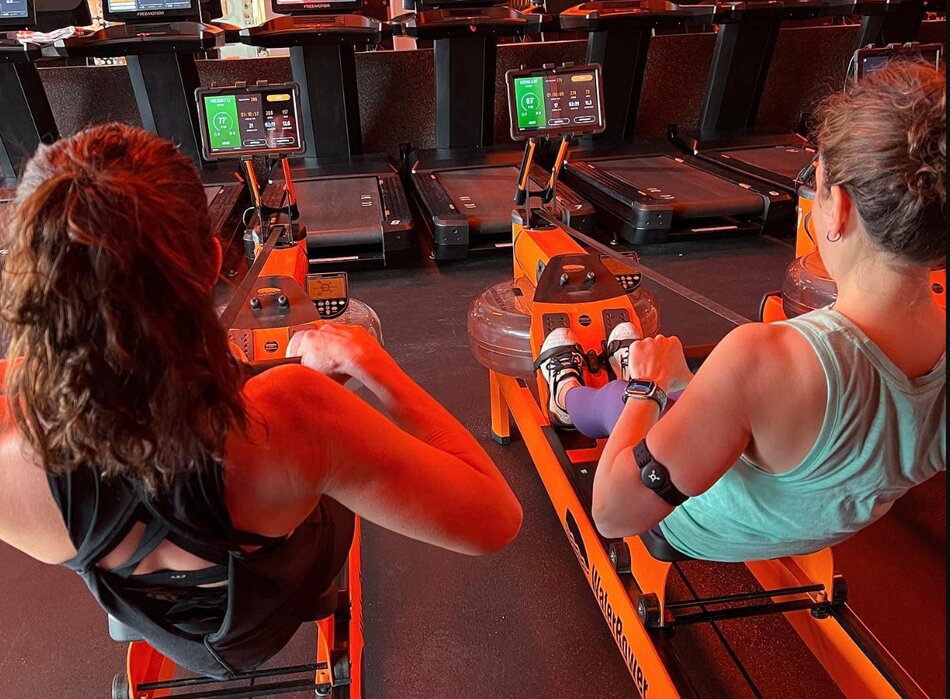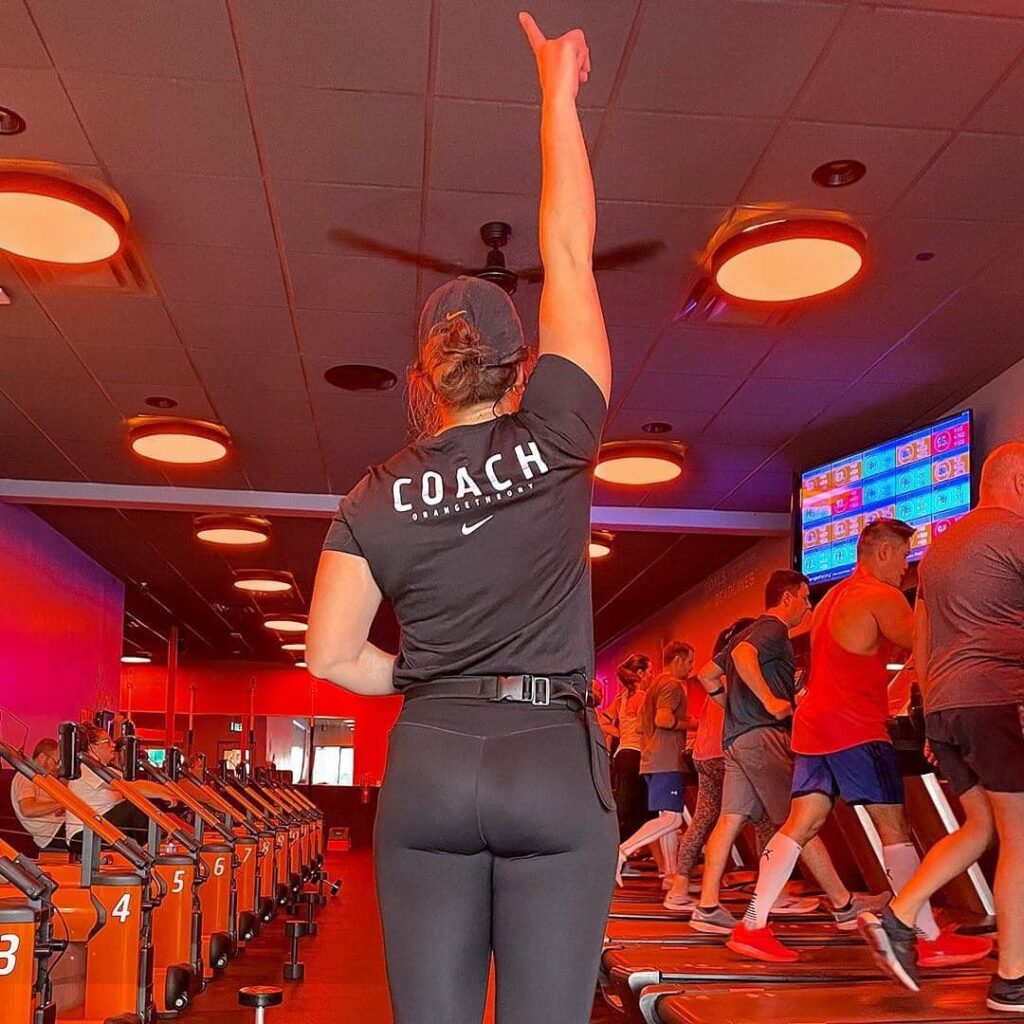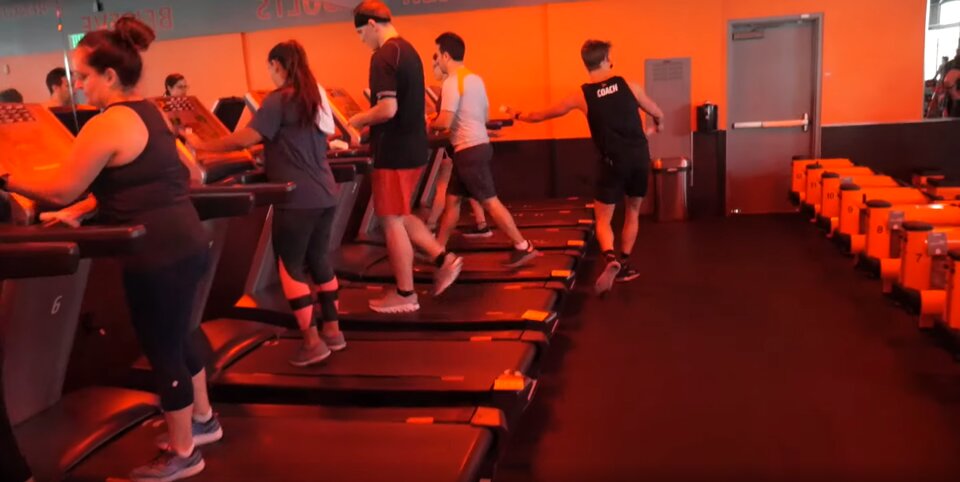Orangetheory Fitness (OTF) classes come in different shapes in sizes. From the number of participants to the overall time in class, Orangetheory workouts can vary slightly. One of the most common variances is the Orangetheory 2G vs. 3G classes.
Reminder – What is Orangetheory?
Orangetheory is a coach-led group fitness class based on heart rate interval training. The class consists of treadmills, water rowing machines, and a variety of other strength and core training equipment.
Orangetheory 2G vs. 3G Overview
The Orangetheory 2G is the classic and original Orangetheory workout.
The class is 60 minutes long and consists of two groups (2G) of members.
In a 2G class, the groups switch stations or sides of the room roughly halfway between the class. Sometimes, more frequent switches occur during a class, but each group ends up spending the same amount of time at each station.
The Orangetheory 3G is a slight variation of the Orangetheory 2G class.
The class is also 60 minutes long and consists of three groups (3G) of members.
To accommodate a larger number of participants, some studios offer 3G classes.
Instead of just two groups, as in a 2G, Orangetheory 3G classes will have members rotate throughout the class by spending one-third of their time on each station (treadmills, rowers, and floor). One group is on each station or side of the room at a time.

Similarities Between Orangetheory 2G vs. 3G
Here are some of the things that 2G and 3G classes have in common.
Workout Days or Types
Orangetheory workout classes consist of Endurance, Strength, Power, or element of all three (E.S.P).
However, more recently, the 3G classes generally are a blend of all three workout types. This makes 3G classes ESP-type workouts.
Exercises
Within the 2G and 3G class, you’ll typically see the same, if not all, exercises on the strength room floor.
Splat Points
In a 60-minute class, the goal is to achieve 12 minutes combined in Zones 4 or 5, or the Orange and the Red.
Whether a 2G or a 3G class, the goal remains the same across the heart rate zones.
Coaches
Once certified, all Orangetheory coaches can coach a 2G and 3G class.
However, Orangetheory typically requires coaches to have completed a certain number of classes before becoming certified to complete 3G classes.
Some studios might make exceptions.

45 Minute Versions
A 45-minute class version (as opposed to the usual 60-minute class version) of both the 2G and 3G is essentially the same as its respective 60-minute version.
However, sometimes, certain exercises are omitted from the 45-minute version to allow for the reduction in time.
Differences Between Orangetheory 2G vs. 3G
Despite being similar Orangetheory classes, here are some of the things that 2G and 3G classes don’t have in common.
Coaches
Related to similarities, the same coaches at your studio facilitate both 2G and 3G classes.
However, a particular coach might only be 2G-certified for a period of time until they acquire the prerequisite number of classes and/or get certified to be able to facilitate a 3G class.
Class Size & Stations
By design, 3G classes increase class capacity by a third.
With all 3 stations being utilized in a 3G, the studio can accommodate a larger number of members.
The 2G, in comparison, will be capped at two-thirds of the entire studio’s capacity.
For example, the standard OTF studio consists of 12 treadmills, rowers, and floor stations each:
- Treadmills = 12
- Rowers = 12
- Floor Stations = 12
- Total Stations = 36
With a 2G class, only 2 groups will be utilized at a time = 24 members.
2G vs. 3G Class Size Summary
| Standard Studio Size | 2G Example (Same for Standard or Larger Studio) | 3G Example (Same for Standard or Larger Studio) | |
| Treadmill | 12 Stations | Generally, one of two groups is always on the Treadmill; members typically spend 1/2 of their time on the Treadmill. | One of three groups is always on the Treadmill; members spend 1/3 of their time on the Treadmill. |
| Rower | 12 Stations | Generally, one of two groups is either on the Rower and/or Floor; members typically spend 1/2 of their time on the Rower and/or floor. | One of three groups is always on the Rower; members spend 1/3 of their time on the rower. |
| Floor | 12 Stations | Generally, one of two groups is either on the Rower and/or Floor; members typically spend 1/2 of their time on the Rower and/or floor. | One of three groups is always on the Floor; members spend 1/3 of their time on the floor. |
Block Times
With overall class time divided between three stations in a 3G format,
overall aggregate block times per station in a 3G will be less than a 2G.
For example, in a 2G, you might be able to spend half your time on the treadmill and the other half on the floor/rower. In a 3G, this isn’t possible with 3 groups going on all stations.
In a 2G, you could spend 23 minutes on the treadmill, but in a 3G this would likely be reduced to 14.
Rowing
With all three stations in simultaneous use in a 3G, you’ll almost always row more in a 3G class than a 2G.
There are exceptions depending on the workout template, but you’ll expect to row more in a 3G on a typical day.
Exercises
Overall, most exercises will be the same.
Due to the time differences though, you might not see all of the same exercises included in the 2G as part of the 3G floor or strength blocks.
However, 3G classes will also often include exercises on the rower that might not be covered in the 2G format.
Recovery Times
Overall, rest or recovery times should generally be the same between a 2G and 3G.
Some 3G templates might provide a bit more time in-between station switches than a 2G template, but this isn’t material nor, usually, noticeable.
What else should you consider before taking an Orangetheory 2G vs. 3G Class?
Assuming you’re interested in or are already are taking Orangetheory, here are some things to consider.
Class Offering
Most studios offer both 2G and 3G classes but not always every day and at the same time of days.
In general, studios tend to offer 3G classes are more popular times to accommodate the larger number of members attending class.
This is typically in the morning before the working day or in the late afternoon after work as well.
Your Schedule
Some members prefer 2G vs. 3G or vice versa.
Some people might go out of their way to avoid one particular type of class, but most often members go to any class that best fits into their schedule.
Running vs. Rowing
During a Run-Row template, a 2G class will actually be a Run-Row.
A Run-Row is a block where you start on the treadmill or rower and then switch back-and-forth between each – all within the same block.
On a 3G, this is not possible, as all three stations will be occupied at the same time.
Overall, you’ll also see more running in a 2G vs. 3G class, regardless if the template is a Run-Row or not.
Impacts on Benchmark and Signature Workouts
On certain days, the 3G 45-minute classes might not include a particular Benchmark challenge.
For example, one of the treadmill Benchmarks is the 12-minute run for distance. With the typical 3G 45-minute class total block time on each station equaling 9.5 minutes, you won’t be able to do a 12-minute run for distance.
You’ll need to do a 45-minute 2G class or one of the two 60 minute classes (2G or 3G) in order to complete this benchmark challenge.
Spacing in the Studio
If you prefer more space, a 2G will have fewer people than a 3G.
While this might be different in the quarantine and post-quarantine worlds, you’ll also find more space overall in the 2G as not all 3 stations are occupied at the same time.
Overall, which class you attend will often come down to scheduling and availability.
Which Is Better for Beginners?
Well, most beginners find more difficulty rowing than with all the other stations. Therefore, 2G is the best option since you can always forego rowing and concentrate on running and strength training, where the correct form is not much of a challenge.
Which Burns More Calories 2g Or 3g?
I generally get close to the same burn. No real difference. It’s more about the template of the day that makes more of a difference for me. I burn way more when there’s heavy rowing involved. 3G always has that.
Now, I have been working on my rowing form 2g, you get more time in the weight room and muscle gain burns more calories at rest but 3g you get more rowing time and the water tower using every muscle in your body.
I think it really depends on how much you can get your heart rate up on the rower. When I first started, I couldn’t sustain a good pace on the rower in 3G. Now it’s more even. I actually like 3G better now!
Is Orangetheory 2G or 3G Harder?
Orangetheory 2G and 3G are high-intensity, making them really hard. Also, one is required to target at least 12 splat points in the whole class, meaning at least 12 minutes in levels 4 and 5 of the heart rate zones. These zones are represented by Orange and red consecutively and are the most strenuous.
However, 3G is harder than 2G, given that the breaks are shorter to utilize each station before the next group comes fully. Also, you have no choice but to participate in all the three-station exercises, unlike with 2G classes.
Pros and Cons of 2G and 3G
I like both 2G and 3G. But 3G feels like it goes by faster and 3G typically has a lot more rowing than 2G which I enjoy.
If you love the treadmill and don’t think you get enough time at each station in a 3g then I prefer 2G
Orangetheory 2G and 3G template
Orangetheory 2G (60 minutes) template
Tread Block 1 – 7 minutes
- 2 min push
- 45-sec base
- 1 min push @ 4%
- 45-sec base
- 1 min push @ 4%
- 45-sec base
- 45 sec AO
Tread Block 2 – 6.30 minutes
- 90-sec push
- 45-sec base
- 1 min push @ 3%
- 45-sec base
- 1 min push @ 3%
- 45-sec base
- 45 sec AO
Tread Block 3 – 6 minutes
- 1 min push
- 45-sec base
- 1 min push @ 2%
- 45-sec base
- 1 min push @ 2%
- 45-sec base
- 45 sec AO
Floor Block 1 – 7 minutes
- 20 stroke push row (check distance)
- back-to-back superset:
- 8 x chest press
- 8 x chest fly, rest
- 4 each x cross back lunge
Floor Block 2 – 6.5 minutes
- 20 stroke push row (check distance)
- back-to-back superset:
- 8 x upright row
- 8 x high row, rest
- 8 x sit up stand to shoulder press
Floor Block 3 – 6 minutes circuit
- 8 x full v up
- 8 total x seated alt oblique knee tuck
- 8 total x low plank alt wide knee drive
- Finisher: 45 sec of sit up stand to shoulder press
Orangetheory 3G (60 minutes) template
Tread Block 1 – 4 minutes
- 1 min push
- 30-sec base
- 1 min push
- 30-sec base
- 1 min AO
Tread Block 2 – 4 minutes
- Goal – match or beat your distance from block 1
- 1 min base to push
- 1 min push
- 1 min push to AO
- 1 min AO
Tread Block 3 – 4 minutes
- Goal – match or beat your previous best distance.
- 3 min tread for distance
- 1 min AO
Row Block 1 – 4 minutes
- 200m AO row
- 20 x pogo hops
Row Block 2 – 4 minutes
- 150m AO row
- 20 x quick feet exchanges
Row Block 3 – 4 minutes
- 100m AO row
- 20 x twist hops, repeat
- Finisher: 1 min AO row
Floor Block 1 – 4 minutes circuit
- 6 each x low bench reverse lunge to single leg hop
- 12 total x low bench high plank up and down
Floor Block 2 – 4 minutes circuit
- 6 each x single arm clean to press
- 12 x low bench high plank jack x 12
Floor Block 3 – 4 minutes circuit
- 6 each x single arm snatch
- 12 x low bench bridge
- Finisher: 1 min of alt single arm snatch
What is the Orangetheory 60 Workout?
Orangetheory 60 workout refers to the common Orangetheory exercise, where you spend 60 minutes in a class. Usually, the 60 minutes are split for power, endurance, and strength training on the treadmills, rowing machines, and floor exercises.
Conclusion
Orangetheory 2G refers to two groups in a single Orangetheory class, while 3G refers to 3 groups in a single class. In 2G, one has the freedom to switch among the three exercise stations, while one is restricted to a station in each duration in 3G classes.
Given the information above, you can now decide which Orangetheory class works for you, though a combination is always great if both are available.
Get More Info:
- Orangetheory Results: What Can You Expect in 1 to 12 Months?
- Most Common Orangetheory Class Schedule
- Does Orangetheory Have Childcare?
- How Much Do Orangetheory Coaches Make?
- Does Orangetheory have a Student Discount?
- How to Use Orangetheory Fitness Membership At Any Location?
- Does Orangetheory Have Showers and Lockers?
- Does Orangetheory Have a Family Plan? (Discount and Policy)


I had two goals today and I met (exceeded) both of them. Started on the floor/rower and the goal was to just finish the entire block before the finisher. Finished a couple minutes before the finisher (only the second time I’ve ever finished all exercises and rows). Goal on the treadmill was to reach the 5k (3.10 mile) mark at 19:00 minutes and I reached that point during the tread block at 18:36. Fastest 5k I’ve ever done on a treadmill (and that’s after the floor/rower block). Super excited on how I’m starting out 2024!